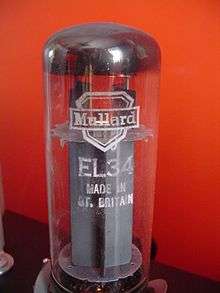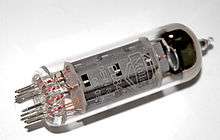Mullard



Mullard Limited was a British manufacturer of electronic components. The Mullard Radio Valve Co. Ltd. of Southfields, London, was founded in 1920 by Captain Stanley R. Mullard, who had previously designed thermionic valves for the Admiralty before becoming managing director of the Z Electric Lamp Co. The company soon moved to Hammersmith, London and then in 1923 to Balham, London. The head office in later years was Mullard House at 1–19 Torrington Place, Bloomsbury, now part of University College London.
Partnership with Philips
In 1923, to meet the technical demands of the newly formed BBC, Mullard formed a partnership with the Dutch manufacturer Philips. The valves (vacuum tubes) produced in this period were named with the prefix PM, for Philips-Mullard, beginning with the PM3 and PM4 in 1926. Mullard finally sold all its shares to Philips in 1927. In 1928 the company introduced the first pentode valve to the British market.
Factories
Mitcham
Mullard opened a new manufacturing plant at Willow Lane, Mitcham, Surrey in 1929. A second building was added in 1936. Both buildings had a very distinctive flat roof construction and were very similar to those at Philips' headquarters in Eindhoven, Netherlands. Co-sited with the Mullard buildings was the manufacturing complex for Philips Radios. Mitcham was also home to the Mullard Application Laboratory.
Blackburn
In the late 1930s Mullard opened a new plant in Blackburn, Lancashire. By 1949 Mullard had produced a number of television sets, such as the MTS-521 and MTS-684. In 1951 Mullard was producing the LSD series of photographic flash tubes.
Others
Mullard had factories in Southport and Simonstone, near Padiham both in Lancashire. The latter closed in 2004. There was also a sister factory at Belmont in Durham (closed in June 2005).[2][3][4][5] Other factories included those at Fleetwood (closed in 1979) and Lytham St. Annes (closed in 1972). A feeder factory at Haydock closed in 1981. A small factory in Hove closed in the early 1970s.
Teletext
In the early 1980s, Mullard manufactured the SAA5050, some of the earliest teletext decoding modules made in the UK.
Semiconductors

- OC200, silicon PNP transistor in an aluminium can.
- Germanium OC45 in a black-painted glass package.
- OC45 in a clear glass and blue putty package, with rubber sleeve
Mullard owned semiconductor factories in Southampton and Stockport. Both sites were owned by NXP Semiconductors (formerly Philips Semiconductors). The Southampton site is now closed. The one in Hazel Grove, Stockport specialises in power semiconductor devices.
The first transistors produced by Mullard were the OC50 and OC51 point-contact types, which were not widely used. In 1953 Mullard moved to junction transistors, beginning with the plastic-cased OC10 series. These were followed by the glass-encapsulated OC43...47,[6] OC70/71, and OC80 series (the output devices were metal encapsulated to facilitate heatsinking), which were produced in large numbers and copied by other companies, such as Valvo (another Philips subsidiary) and Siemens in Germany, and Amperex in the USA. RF transistors were the OC170 and OC171. All these were germanium PNP transistors. In 1964 the company produced a prototype electronic desktop calculator as a technology demonstrator for its transistors and cold cathode indicator tubes.
Space science
In 1957 Philips-Mullard helped to set up the Mullard Radio Astronomy Observatory (MRAO) at the University of Cambridge. In 1966 the Mullard Space Science Laboratory (MSSL) was opened near Dorking, Surrey as part of University College London. The Royal Society Mullard Award[7][8] for young scientists and engineers was set up in 1967.
Mullard brand name
Philips continued to use the brand name "Mullard" in the UK until 1988. Mullard Research Laboratories in Redhill, Surrey then became Philips Research Laboratories. As of 2007, the Mullard brand has been revived by Sovtek, producing a variant of the ECC83 and EL34.
Z Electric Lamp Company
The Z Electric Lamp Co. continued business into the 1970s operating from premises in Thornton Heath, South London, manufacturing lamps of specialised design. However, it closed due to the recession in the mid 1970s.
See also
References
- ↑ "Mullard". The National Valve Museum. Retrieved 14 January 2017.
- ↑ Grimley, Robert (2016) [2011]. "Mullard & CES - Mullard & Combined Electronic Services (CES)". Early Philips Colour TV. Archived from the original on 2017-10-27. Retrieved 2017-01-14.
- ↑ Milner, Mark (2 March 2005). "Union says LG Philips is to close Durham factory". The Guardian. Retrieved 14 January 2017.
- ↑ "LG Philips closure marks end of an era". The Journal. 23 July 2005. Retrieved 14 January 2017.
- ↑ Woodcock, Ray (January 2006). "And Then There Were None" (PDF). Philips Electronic Pensioners. Retrieved 14 January 2017.
- ↑ Note: Mullard's OC43...47s were germanium-PNP, while Clevite-Intermetall's OC43...47s, sold at the same time, were silicon-PNP
- ↑ "Royal Society Mullard Award: Mullard Medallists". Royal Society. London. 2016. Archived from the original on 19 July 2016.
- ↑ "Mullard Award". Royal Society. Archived from the original on 14 October 2006.
External links
| Wikimedia Commons has media related to Mullard. |